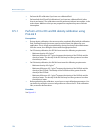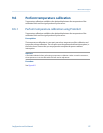
10 Troubleshooting
Topics covered in this chapter:
•
Status LED states
•
Status alarms
•
Flow measurement problems
•
Density measurement problems
•
Temperature measurement problems
•
Milliamp output problems
•
Frequency output problems
•
Use sensor simulation for troubleshooting
•
Check power supply wiring
•
Check sensor-to-transmitter wiring
•
Check grounding
•
Perform loop tests
•
Trim mA outputs
•
Check the HART communication loop
•
Check HART Address and Loop Current Mode
•
Check HART burst mode
•
Check Lower Range Value and Upper Range Value
•
Check mA Output Fault Action
•
Check for radio frequency interference (RFI)
•
Check Frequency Output Maximum Pulse Width
•
Check Frequency Output Scaling Method
•
Check Frequency Output Fault Action
•
Check Flow Direction
•
Check the cutoffs
•
Check for slug flow (two-phase flow)
•
Check the drive gain
•
Check the pickoff voltage
•
Check for electrical shorts
10.1
Status LED states
The status LED on the transmitter indicates whether or not alarms are active. If alarms are
active, view the alarm list to identify the alarms, then take appropriate action to correct
the alarm condition.
Troubleshooting
Configuration and Use Manual 159


















